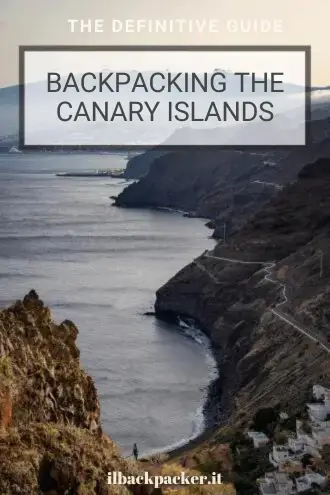Canary Islands Travel Guide
I visited the Canary Islands archipelago during a two-month trip, during which I explored all the major islands of the archipelago except for El Hierro.
Whether it’s a backpacking adventure, a road trip or an all-inclusive vacation, you’ll find plenty of valuable tips and insights in this guide to help you plan your trip to the best of your ability and choose the island or islands that are best for you.
Quick menu
- When to visit the Canary Islands
- Documents and vaccinations to enter the Canary Islands
- What to do and see in the Canary Islands
- Canary Islands travel itineraries
- How to get around the Canary Islands
- Backpacking the Canary Islands: costs
- Backpacking the Canary Islands: what to bring
- Backpacking the Canary Islands: safety

The iconic flowers of the Canary Islands immortalized in La Palma.
When to visit the Canary Islands
The Canary Islands enjoy a good climate throughout the year and can be enjoyed in all seasons. That said, a lot depends on your expectations during the trip and the activities that interest you the most.
Canary Islands in spring
During the spring, temperatures can reach 22-23 degrees and even a few degrees higher toward the end of May when rainfall, which can occasionally occur in March and April, is virtually absent. This makes May ideal for those who want to avoid the crowds and prices that characterise the peak summer season.
Canary Islands in summer
June, July and August are considered high seasons in the Canary Islands. The weather is excellent, rainfall is absent, and the ocean water begins to warm toward the end of July. Of course, this is also the busiest and most expensive time of the year.
Canary Islands in autumn
September is the best month to visit the islands: the beaches are less crowded (especially toward the end of the month), the weather is excellent, and the ocean is warmer than in summer. October is also a good month; the probability of precipitation goes up, but all in all, it is still pleasant. On the other hand, the likelihood of a few showers increases significantly in November, and temperatures drop, marking the beginning of winter.
Canary Islands in winter
Although winter in the Canary Islands is quite different from mainland Europe, and not coincidentally, the Canary Islands are a popular destination during Christmas. December, data in hand, is the rainiest month on record.
Nevertheless, precipitation is still relatively low, and during the day, with the sun shining, temperatures can reach 20 degrees even in January and February. In short, don’t expect to bask in the sun or pleasantly swim without a wetsuit, but if all you’re looking for is some sunshine and mild temperatures, you won’t be disappointed.
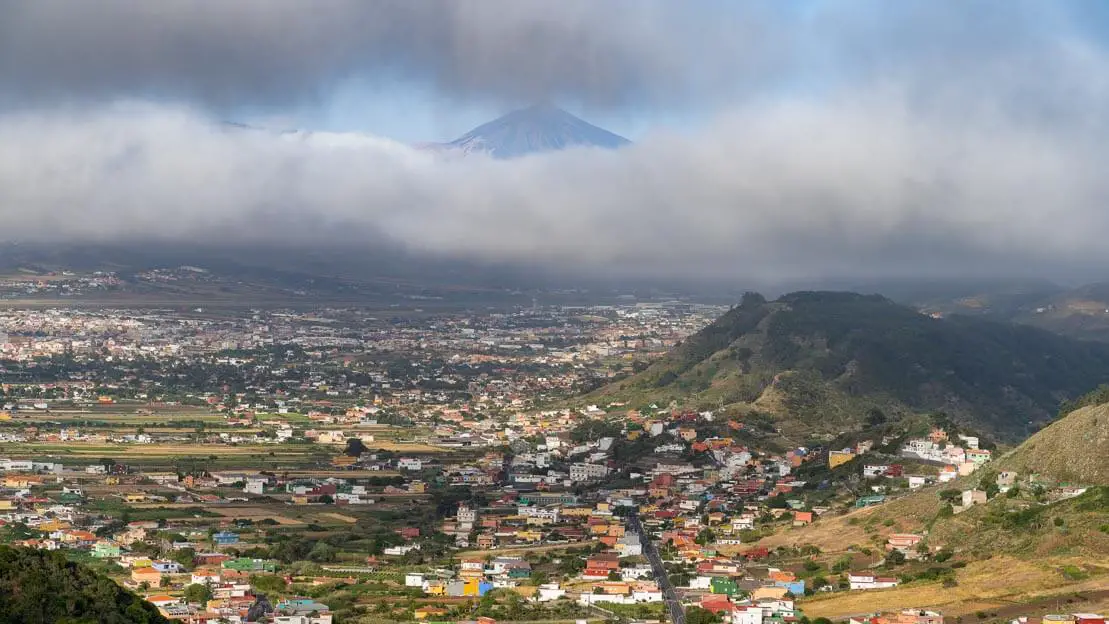
San Cristóbal de La Laguna with Teide in the background.
Documents and vaccinations to enter the Canary Islands
The Canary Islands are, for all intents and purposes, part of Spain, and therefore, like any other country within the European Union, Schengen Area visa policy applies.
What to do and see in the Canary Islands
Below, you will find mini travel guides for all the islands in the archipelago that I visited, a sort of overview with the best destinations and the most beautiful places to visit just to give you an idea of what to expect. For more detailed information, please see the guides for each island.
Lanzarote
Lanzarote is characterised by volcanoes and lava fields that give rise to “Martian landscapes” but also beautiful white and golden beaches – in my opinion, the most beautiful in the archipelago. The island is barren and somewhat like Fuerteventura; it can become monotonous after a couple of days. However, if all you’re looking for is a beach destination to go along with some hiking among volcanoes and lava fields, then Lanzarote is a destination to consider.
For itineraries, things to do, things to see, tips and more, I invite you to check out my travel guide to Lanzarote.
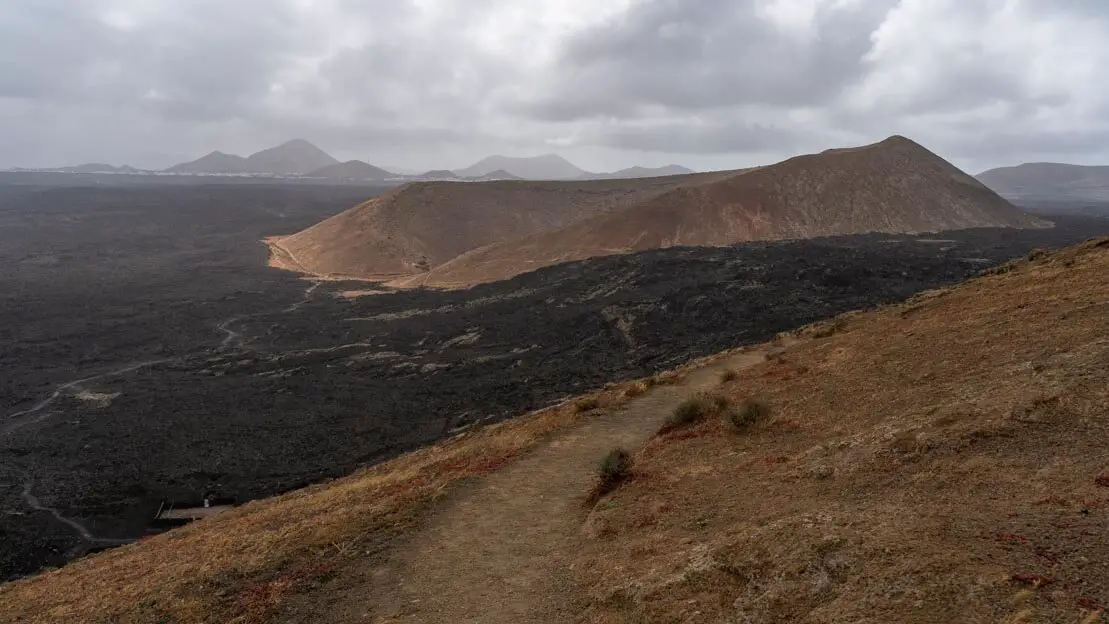
Lava fields in Lanzarote.
Fuerteventura
Fuerteventura, thanks to its many beaches, excellent year-round climate and outstanding surfing and windsurfing conditions, is undoubtedly one of the most well-known and popular islands in the Canary Islands archipelago. Fuerteventura, like Lanzarote, is a barren, almost desert-like island that, in my opinion, can tire you out quickly, but if the beach and sea are all you are looking for, you will not be disappointed.
For itineraries, things to do, things to see, tips and more, I invite you to check out my Fuerteventura travel guide.

Ajuy village.
Gran Canaria
Gran Canaria is an island that has something incredible about it because there is everything: colonial-style villages, beaches, almost desert-like parts and, further inland, mountains and forests that create an alpine landscape in sharp contrast to what is the coast, a few kilometres down. Although not as varied in landscapes as Tenerife, Gran Canaria still offers many alternatives to those who decide to visit.
For itineraries, things to do, things to see, tips and more, I invite you to check out my Gran Canaria travel guide.

Gran Canaria.
Tenerife
Tenerife, the largest island in the Canary Islands archipelago, is best known for its beaches, resorts and nightlife. It is not my favourite island, however, I have to admit that it has a lot more to offer: the Martian landscapes of Teide National Park, which at 3715 meters is the highest peak in all of Spain, the dense Laurisilva forest of Anaga Park, the sheer cliffs of the Teno Massif, and more than a few towns rich in colonial architecture and cultural interest, Tenerife is probably the most diverse island that should please everyone.
For itineraries, things to do, things to see, tips and more, I invite you to check out my Tenerife travel guide.
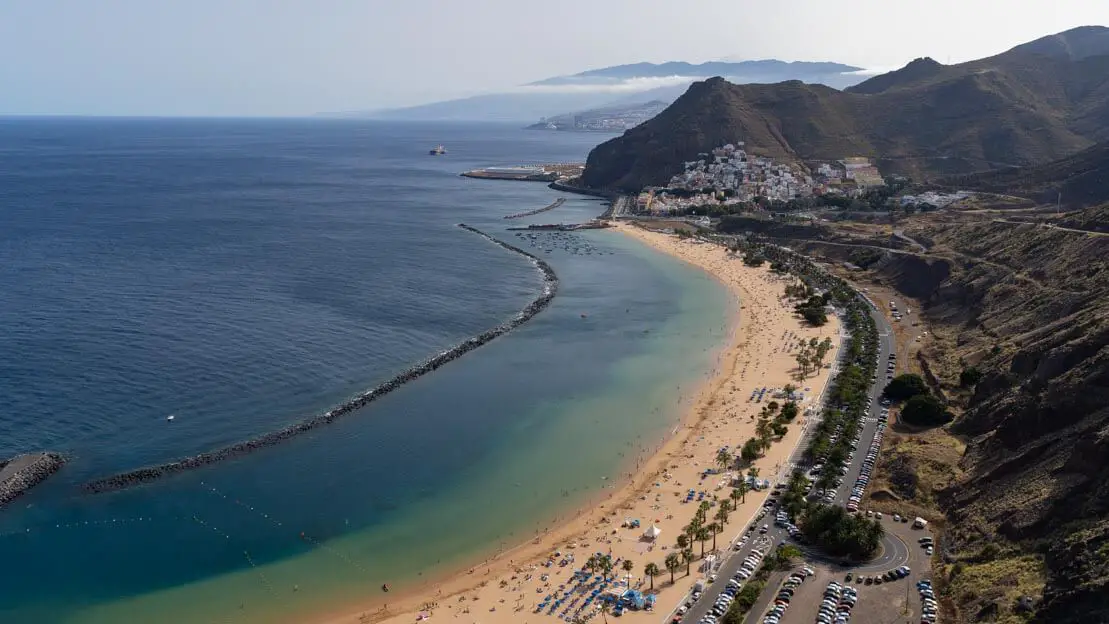
Playa de las Teresitas.
La Gomera
A short distance from the far more popular Tenerife, La Gomera is the exact opposite: compact, with a population of about twenty thousand and largely unspoiled, it offers a unique opportunity to anyone who wants to immerse themselves in nature and, in particular, in the fascinating laurisilva forest that characterises the Garajonay National Park in the centre of the island. The beaches are not the best, but you will not be disappointed if you are looking for a few days to be immersed in nature among what are undoubtedly some of the most beautiful trails in the archipelago.
For itineraries, things to do, things to see, tips and more, I invite you to check out my travel guide to La Gomera.

Foresta di laurisilva all’interno del parco nazionale del Garajonay.
La Palma
La Palma is a mountainous island that offers excellent hiking trails, lush forests, and colonial towns, such as the beautiful Santa Cruz de La Palma, as well as a more authentic atmosphere than other more popular Canary Islands.
As if that were not enough, thanks to its geographical location, the morphology of the land and regulations to limit light pollution as much as possible, the island is one of the best places in the world for stargazing. The only negative note is perhaps the beaches, which are not that nice.
For itineraries, things to do, things to see, tips and more, I invite you to check out my travel guide to La Palma.
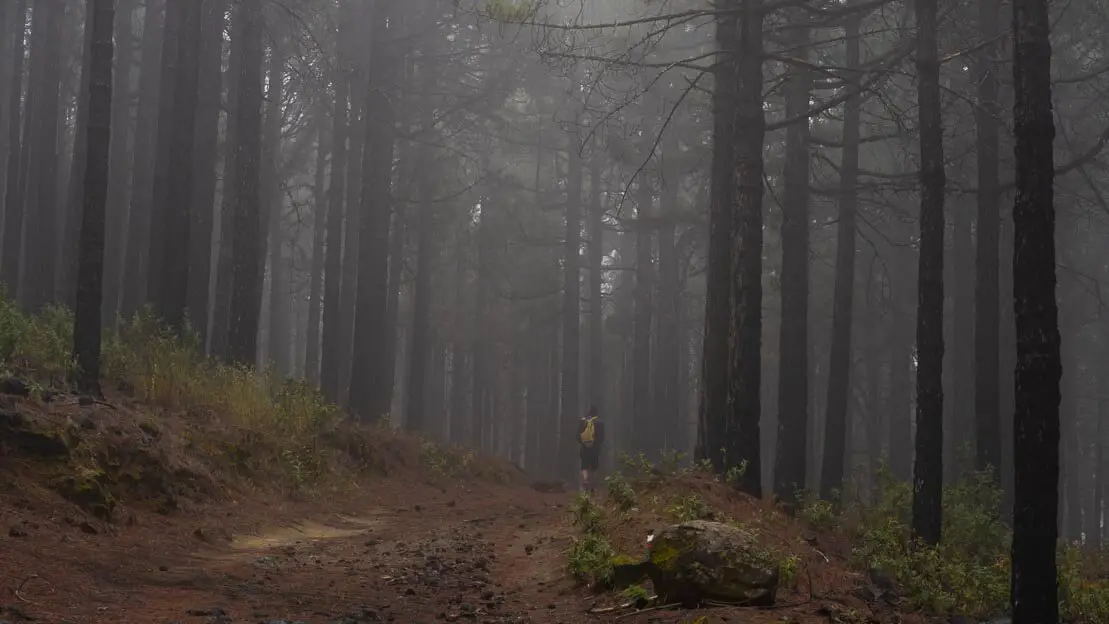
La Palma.
El Hierro
Although it was in the plans, unfortunately, I could not visit the island, so I cannot speak from firsthand experience. Still, I think all nature lovers looking for an untraveled destination and diving enthusiasts–some of the best sites in the world are found here–should consider it.
The island, the smallest in the archipelago, was declared a UNESCO Biosphere Reserve in 2000, which means that most of its flora and fauna are protected.
This, combined with the fact that only about 20,000 visitors a year venture out here, makes it a fascinating island for those who want to unplug and stay away from the classic tourist circuits that characterise the other islands in the archipelago.
Canary Islands travel itineraries
For specific itineraries for each island, I refer you to the dedicated section within the individual travel guides that I link below for your convenience:
Lanzarote, Fuerteventura, Gran Canaria, Tenerife, La Gomera and La Palma.
On the other hand, for those who have in mind a multi-island trip, or perhaps the entire archipelago, the itinerary I recommend following for ease of travel is the one you see roughly in the map below; by doing so, you never have to retrace your steps and can simply continue your journey from island to island westward starting from Lanzarote. Finally, I remind you that the direct connections by ferry and plane to El Hierro are exclusively from Tenerife so plan accordingly.
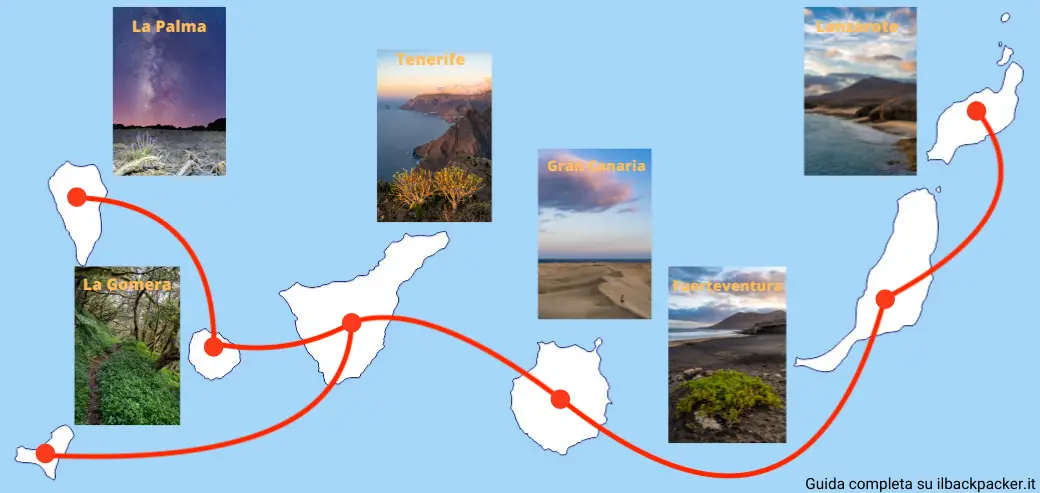
How to get around the Canary Islands
To go to the Canary Islands, you have two options: fly or take the ferry from peninsular Spain, more specifically from the cities of Cádiz and Huelva.
As for flights to the Canary Islands, there are generally direct flights from mainland Europe to many cities in Lanzarote, Fuerteventura, Gran Canaria, and Tenerife. Low-cost airlines such as RyanAir and EasyJet operate these routes, and therefore, especially in the low season, you can find extremely cheap tickets. I recommend looking at my article on how to find low-cost flights.
The ferry to reach the islands I think is only to be considered if you have your minivan or RV and want to spend quite a lot of time on the archipelago, otherwise even if not necessary, I think it is much better to rent a car once you get there.
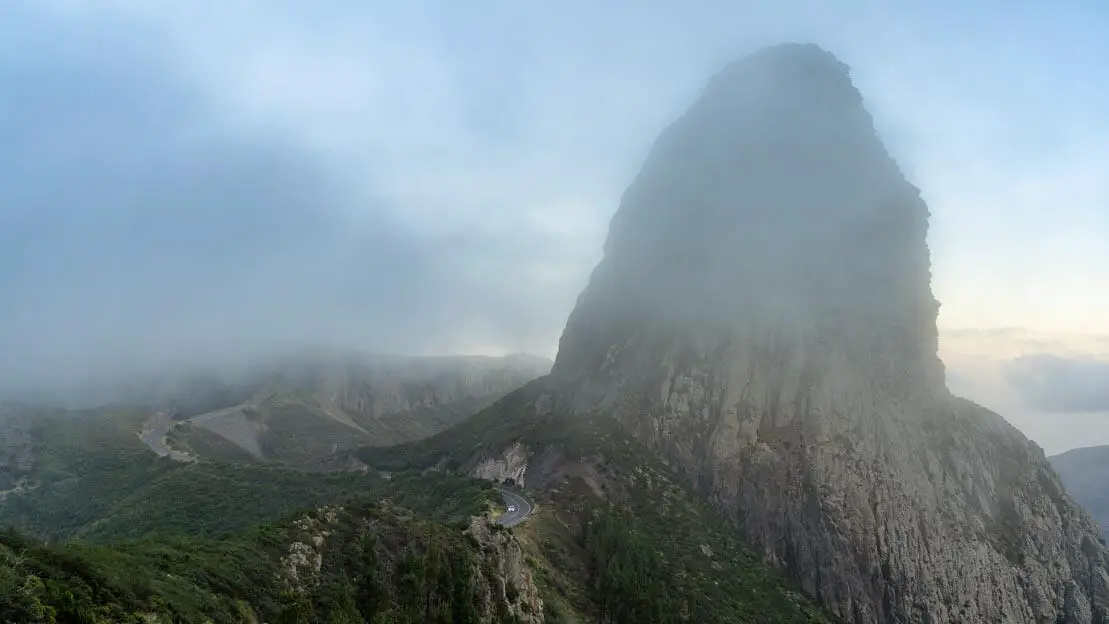
Mirador de Los Roques, La Gomera.
Rent a car in the Canary Islands
In the course of my travels in the Canary Islands, I have almost always ended up renting a car with Cicar: the prices are competitive, you can safely pay without a credit card, no deposit is required, insurance is included, and there are no deductibles, and best of all, they have offices at all the ports and airports in the Canary Islands, which is practical for those who are planning an itinerant trip between the islands. Most other companies have offices only at the airport, which can be inconvenient if, instead of getting on a plane, you want to drop your car off at the port and get on a ferry to another island.
In short, if you have multiple island road trip on your mind or, for whatever reason, you don’t want to drop your car off at the airport, Cicar is probably the best option. Otherwise, it’s worth considering other car rentals by checking out sites like Discover Card. In any case, whether it’s Cicar or any other company, if you have specific dates, I recommend booking the car a few weeks in advance; doing so can save you a lot compared to a last-minute rental.
Also, it should be noted that virtually all companies technically do not allow you to drive on dirt roads; we have done so several times, but if you have any problems, you risk paying out of pocket for any damage.
Finally, some companies technically allow you to take your car to another island by ferry as long as you return it to the island of departure; many, on paper, do not allow you to leave the island at all; of course, there is no one to check in at the port but if something happens, you might get in trouble.
My advice is to rent a different car for each island you visit or at least find out what you are allowed to do.

Playa de Tufia, Gran Canaria.
Public transportation in the Canary Islands
If you are travelling alone and want to save over the cost of renting a car, don’t feel like driving, or for any other reason don’t want to rent a car, public transportation on the islands is not bad at all, and you can reach virtually any destination with a bit of planning. For the reference sites of the various bus companies operating on the archipelago, I encourage you to look at the individual guides.
Domestic flights in the Canary Islands
The only two airlines that operate domestic flights between the islands are CanaryFly and BinterCanarias. Prices tend to be very similar, but generally, Binter seems slightly cheaper and has special fares for those under 29. In any case, look at both and, if possible, book at least a few weeks in advance for the best deals.
Ferries to the Canary Islands
Ferries are the cheapest alternative to flights and are significantly more practical for moving between islands. It is clear that if you have to get to La Palma from Fuerteventura, it is better to fly. Still, for adjacent islands, not only do you save money by taking the ferry, but it is much more convenient as you don’t have to show up at the airport two hours earlier but can simply go to the port an hour earlier or even less, buy your ticket and board without necessarily booking your trip in advance.
Moving by ferry gives you much more flexibility if you don’t have a well-established itinerary with specific dates. In any case, several companies operate between the islands. Direct Ferris is a site that aggregates all the companies, and you can book your tickets if you want.
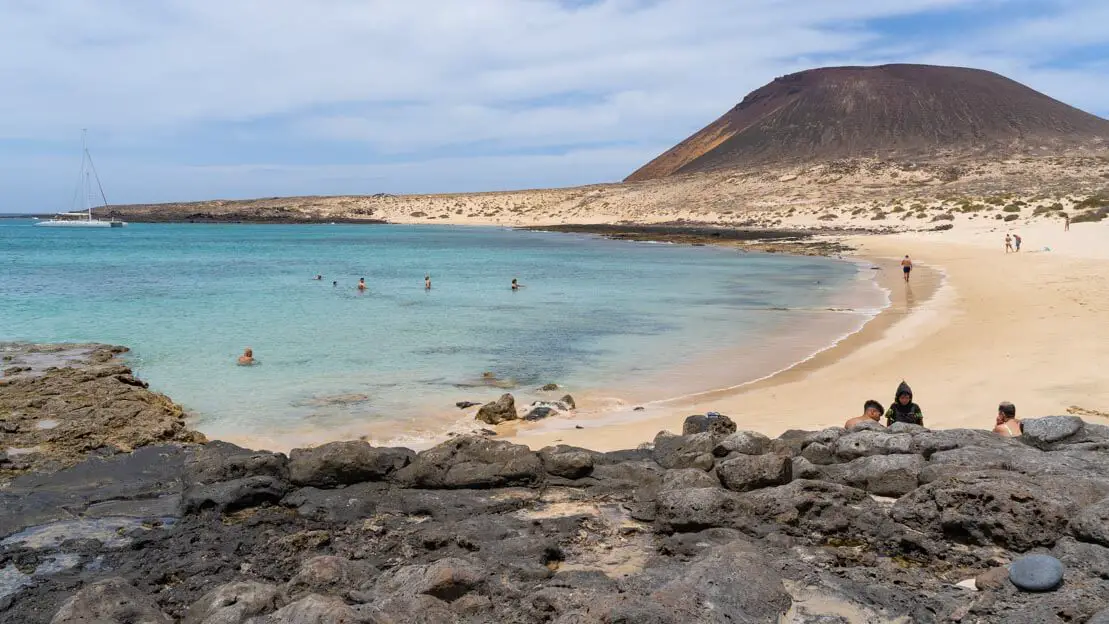
Playa Francesca, La Graciosa.
Backpacking the Canary Islands: costs
How much does a trip to the Canary Islands cost? The budget to visit the Canary Islands depends on how you travel and the activities/tours you will do. Those who read my blog know that I travel exceptionally frugally, and my trip to the Canaries was no exception. I managed to maintain a budget of €1,000 per month, or just over €30 per day all-inclusive. The budget can be summed up as car rental (split with a friend), almost all cooked meals and a lot of camping; if you are looking for ideas on saving money, check out this article.
I fully realise that not everyone is willing or interested in the backpacker’s life. However, the good news is that the Canary Islands are still a relatively inexpensive destination by European standards.
Prices, in general, are lower than in mainland Spain itself, as the islands are a kind of special region where VAT is only 7 per cent and on many consumer goods, you don’t pay it at all. To give two examples, gasoline costs about 1€ per litre, and a dinner at a restaurant, if you don’t have high demands, costs about 10€ or a little more. In short, they may not be Latin American prices, but you certainly cannot complain by European standards.
Since we are talking about costs, I think it’s good to say a few words about a great way to keep them low: camping. Free camping in the Canary Islands is technically illegal, but it is widely tolerated. If you pitch your tent away from prying eyes, you should not have any problem. Even better, given the low rainfall that characterises the summer period, you don’t need to pitch your tent at all. Many nights during my stay in the Canary Islands, I simply inflated my camping mat at some beach when it was bedtime. Again, though, it’s technically illegal; the choice is yours.
If you want to stay within the law, virtually all islands have at least some option for camping without breaking the law, and in the case of government campgrounds, it is completely free. Booking arrangements vary from island to island, so I encourage you to look at the cost section of the individual guides, where you will find more precise information. Finally, to find places in the Canary Islands to camp, I recommend the app park4night, designed especially for those who want to spend the night in an RV, minivan, or car. It is also a fantastic resource for those who simply want to find a secluded place to pitch their tent or put down a sleeping pad. Sleeping in a car or, better yet, in a minivan or RV is legal everywhere, with a few rare exceptions.
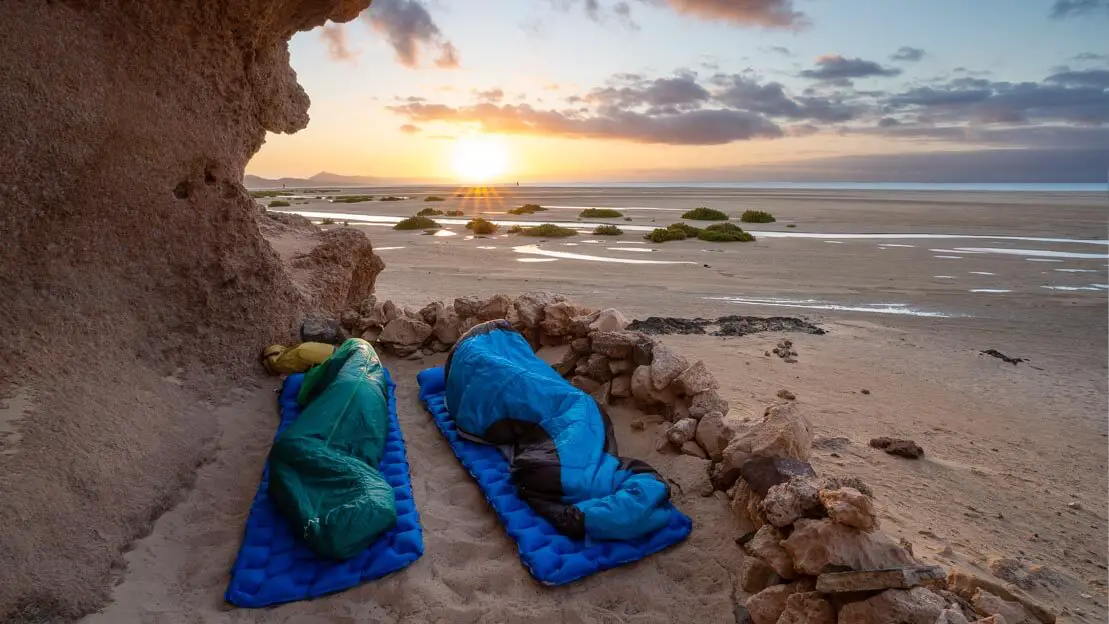
Laguna de Sotavento.
Backpacking the Canary Islands: what to bring
Of course, it depends on the time of year you decide to visit the archipelago and especially the activities you plan to do. For example, if you plan to spend two weeks on the beach in the middle of summer, you won’t need much.
If, on the other hand, you plan to climb to the top of Teide in the middle of winter or perhaps take a multiple island touring trip, which includes not only beaches but also some trekking, especially at high altitudes, then I strongly recommend that you also bring some slightly heavier clothing since although in generally warm latitudes, some regions of the islands can have less than tropical temperatures due to the altitude and, especially at night or in strong winds, it can get freezing.
That said, travelling light is far from impossible, and I invite you to look at my travel packing list, which I always use as a starting point when it’s time to pack my backpack for my travels.
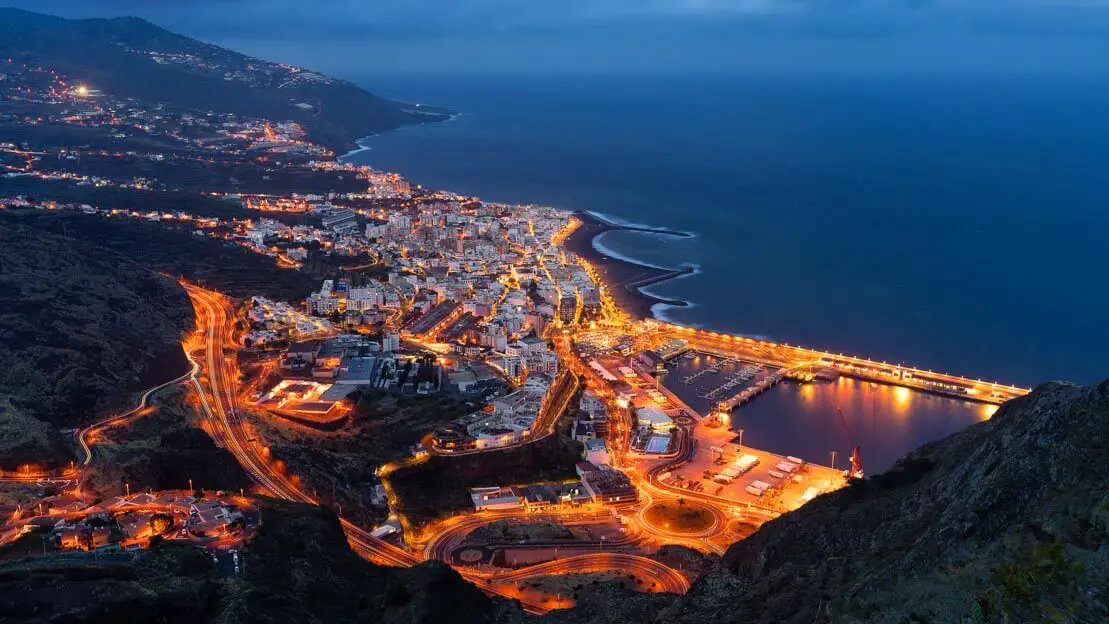
Santa Cruz de La Palma.
Backpacking the Canary Islands: safety
The Canary Islands, in general, is a safe destination with meagre crime rates. Therefore, they are also recommended for families with children. As with any destination, common sense should be used and following classic safety tips never hurts.
The only two notes I would make are to be extremely careful where you swim. Since this is the ocean, the currents can be hazardous on some beaches, especially the rip currents, which can quickly take you out to sea with potentially fatal consequences. I had the opportunity to meet a gentleman who was taken offshore with his children, and he told me how he had already seen the end of it. It was not exactly a good experience.
Also, many of the more isolated beaches do not have lifeguards, and especially in the off-season, you may be the only person there. In short, especially if you are not an experienced swimmer, be careful.
Finally, if you decide to rent a car, make sure you do not leave any valuables inside when unattended. Unfortunately, seeing broken glass in parking lots and signs urging people not to leave anything in their cars is all too familiar.
Do you have any questions? Updated information? Feel free to leave a comment or message me on Instagram!
If you found this article helpful, please consider purchasing your travel insurance through one of the links on this site, doing so supports my work at no additional cost to you. For EU & UK Residents, i recommend True Traveller. For everyone else i recommend HeyMondo (5% discount). Thanks!
For donations/pizzas and virtual beers 🙂
Did you like the post? Pin it!
